|
|
They Gave Their Lives…
The story of a Bomber Crew
of 149 (East India) Sqn R.A.F.
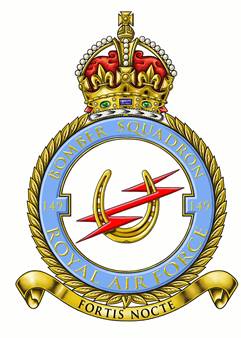
In Memory
of
Flt Sgt F. P. J. Brady RAAF. AUS 424361
Wireless Operator
149 (East India) Sqn. RAF
Flt Sgt Frank Brady was killed in action during a raid on Brest, Brittany on 23/24th June, 1944, when his aircraft and crew were lost.
The crew Wireless Operator, Francis (Frank) Patrick Joseph Brady, was born on the 18th of August 1923, at Murrumburrah, New South Wales. His parents were Francis Joseph Stanislaus Brady & Elizabeth Kearins, who had married in 1919 at Waverley, NSW.
Frank was the third of the four children of the marriage: Mary Philomena (1920), Elizabeth Anne (1922), Frank (1923) and Patrick Kearins Anthony (1926). The daughter of Patrick, Mrs Sue Whiteley, contacted the 149 Squadron Historian, requesting more information about her Uncle, hence this story.
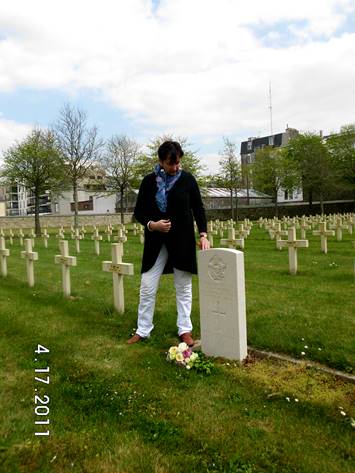
Frank - at Peace. Courtesy: Sue Whiteley
The family had moved to Wagga Wagga in New South Wales and, soon after, Frank was born. Francis Snr, his father, owned a store in Murrumburrah, but moved on to become a qualified accountant in Wagga. His name still exists in the Company, F.J. Brady & Co. Accountants, Fitzmaurice St., Wagga.
As a school student, at Christian Brothers High School, Wagga, Frank was an all-rounder. He was academically gifted, a leader and most of all a sporting star. He captained the school’s football and cricket teams, was School Captain and was the apple of his father's eye. Patrick followed in his footsteps and achieved similar success, but lived a little in Frank's shadow.
Frank’s presence in Bomber Command at that time in the war was interesting. Most Australian service personnel were being drawn back from Europe, to fight in the Pacific/Asian theatres. Other relatives were engaged in battles in New Guinea, some as commandos. It is also both interesting and revealing that, in view of the history of the family, fighting for the Allies and specifically Britain was quite a big step. Frank's mother was the daughter of Irish ‘Potato Famine’ immigrants, whose story was one of English oppression. For them, the journey to Australia was the only alternative to staying in Ireland and probably dying of starvation, as other family members had. Frank’s grandfather, Patrick Kearins, is said to have refused his sons permission to enlist in World War 1 saying, "No child of mine is going to fight for those English b......s". Nonetheless, Patrick joined up in the AIF (Australian Imperial Force) during the time Frank was missing, much to his parents' concern, him being only 18 years of age at the time.
The impact of Frank's death on the family is hard to explain, as it is in the stories of many. Both his sisters married war veterans; one (also an airman) committed suicide in 1952 leaving 3 young children. The other kept his wife and children isolated from family. Frank's father died in 1951. This caused his mother to suffer deeply in a relatively short time and the events affected her strongly. The family were not financially well-off, so Patrick was not able to visit his brother's grave as he would have wished. Patrick’s daughter, Sue, fulfilled a long-given promise to him when she eventually managed to visit the grave in 2011. (Leading picture)
Frank’s Training
Training for a Wireless Operator was a thorough and exhaustive process, where instructors gave practical demonstrations on W/T aids to navigation and passed on their knowledge and expertise. The aim of the course was to produce a well rounded, embryonic crew member who would quickly fit into a crew
Training exercises carried out were designed to prepare these trainees for the rigours of an Operational Squadron. To this end they received a full briefing before every exercise. The objectives of the exercise and the equipment and information they would use on the exercise was passed to them at this briefing. Testing was an integral part of the course. They were tested on arrival and then on a weekly basis, with observations from the staff.
The various drills required were to be committed to memory and carried out incessantly. Morse code was a ‘must have’ and expertise in this area closely monitored. Trainees could frequently be heard conducting conversations in Morse as exams approached. Training was made as realistic as possible with bad reception, proper radio kit and interruptions a standard part of their lot. The post exercise analysis was closely looked at, as well. Mistakes were highlighted and alternative scenarios discussed. Nothing was left to chance. But Morse was not the only hurdle. Aircraft electrics, systems and maintenance were all part of the curriculum. His skill with the equipment must extend beyond the basic operating level to be acceptable.
His training would also include snippets of the other positions in the aircraft., with an emphasis on Navigation. This would be his secondary role in the crew, so he needed to know the subject well. As the War had progressed, the importance of the team work between the navigator and wireless operator had grown, to the point where they assisted each other throughout the flight.
149 (East India) Squadron. 
As war had approached, No 149 (East India) Squadron, which had served briefly in World War I, was re-formed in 1937 at RAF Mildenhall as a night heavy bomber unit. It was initially equipped with the last RAF heavy bomber biplane, the Handley Page Heyford, but not for long. In early 1939 these were replaced with the new geodetic structured Vickers ‘Wellingtons’. Designed by Barnes Wallis, of Dam Buster fame these were sturdy, reliable aircraft which could absorb a great amount of damage and still return home. Even these warhorses were inadequate for the task ahead and the Squadron was re-equipped with the first of the RAF’s heavy bombers, the Short’s Stirling. The crews either loved or hated the aircraft, depending on their experiences. For its day it was a fine aircraft , but due to a short wingspan it had neither the service ceiling or speed of the later Halifax and Lancaster bombers. By December 1943 Stirlings were being withdrawn from frontline service as bombers. They were huge, slow, lumbering and flew best at low altitude. As the Luftwaffe night fighters, now fitted with Airborne Interception radar became more efficient, the Stirling losses became excessive and unacceptable. With more and more of Bomber Command switching to the Lancaster it was decided to withdraw the Stirling from bomber operations over Europe, restricting it to targets along the coast and to mine laying, with occasional supply drops to the partisans in France. 149 Squadron had been involved in the War from day one. It was one of the few squadrons which served all the way through the conflict. It was to this squadron that the crew was posted.

Short ‘Stirling’ of similar vintage as OJ-M
The Aircraft.
The Aircraft was a Mk III Short Stirling, serial number EF188 and coded OJ-M on the strength of 149 (East India) Sqn, RAF. It had arrived on the Squadron on the 12th June, 1944 from 90 Sqn. 90 Squadron was also in No 3 Group, switching from the Stirling to the Lancaster and phasing out their Stirlings from May to June 1944. The Stirlings would either be sent to MU’s for storage and eventual scrapping, or as a replacement to squadrons who were still actively using them. As part of this process, EF188 was transferred to Methwold and No 149 squadron. 149 was the last squadron in Bomber Command to use the Stirling on bomber and mine laying operations.
The Crew.
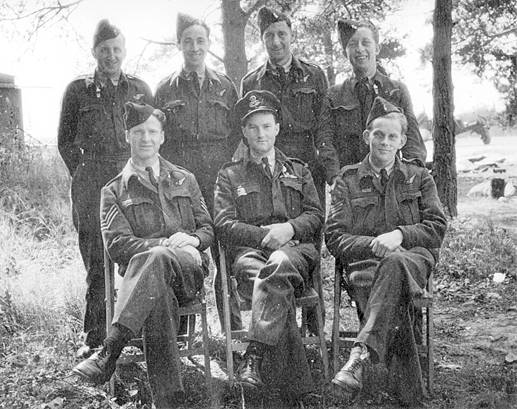
Second row, left to right: F. Brady, E. Duckworth. E. Eaton, H. Fox
Front row, left to right: , R Mc Quitty, T. Lincoln, L. Richards.
Picture source: Gildas Saouzanet, Brest Flying Club.
The Crew were:
P.O. E J Lincoln RAAF Pilot AUS 426358
P.O. H.W.G. Fox RCAF M/U/Gunner CAN R200720
Flt Sgt F P J Brady RAAF W/Op AUS 424361
Flt Sgt R J McQuitty RAAF Air Bomber AUS 408338
Flt Sgt L R Richards Navigator
Sgt E R Duckworth Flt Engineer
Sgt E D Eaton Rear Gunner
Crew Operational History.
Having, ‘crewed Up’ at an OCU or HCU the ‘Rookie’ crew would have arrived on 149 Squadron and gone through the normal Pre-Op work-up of flying training and ‘Bullseye’ exercises until the team was considered competent to undertake full ‘Ops’.
1st Operation. – 20/21st May 1944
Stirling III, Serial number LK397, code OJ-K (Illustrated earlier). Took off from RAF Methwold at 22.45 and landed at 02.30. Mission – Mine laying ‘Le Havre’ area. Mission abandoned at 49.48N by 01.00W at 00.15 hrs. .DR (Dead Reckoning) compass de-synchronised by 40, that giving track made good. This caused the Nav to distract his GEE fix. Gee fixes unreliable.
2nd Operation. - 24/25th May 1944
Stirling III, Serial number LK397, code OJ-K. Took off from RAF Methwold at 22.30 and landed at 01.56. Mission – Mine laying, West Frisian Islands. Clear apart from a light sea haze. 5 Parachutes seen to open. Mines laid as ordered.
3rd Operation.- 27/28th Mat 1944
Stirling III, Serial number LJ621, code OJ-M. Took off from RAF Methwold at 22.49 and landed at 04.39. Mission – Mine laying, La Rochelle area. Mines laid as ordered. Clear, good visibility.
4th Operation. – 2nd June 1944
Stirling III, Serial number EE963, code OJ-N. Took off from RAF Methwold at 23.46 and landed at 02.46. Mission – Mine laying off Ostend (Knocke). Not completed. Unable to get definite Gee fix.
5th Operation – 6/7th June 1944.
Stirling III, Serial number LJ577, code OJ-E. Took off from RAF Methwold at 23.46 and landed at 04.06. Mission – Mine laying, Brest area. Mines laid as ordered. All six parachutes observed to open. 3/10ths cloud, base 300ft. Good visibility.
6th Operation – 7/8th June 1944
Stirling III, Serial number LK386, code OJ-O. Took off from RAF Methwold at 22.13 and landed at 03.08. Mission – Mine laying at Brest. Mines laid as ordered. Thin cloud at 1000 ft.
7th Operation. The Final Trip. 23/24th June 1944.
The aircraft, a Stirling III serial number, EF188 coded OJ-M, took off from RAF Methwold at 21.19hrs on the 23rd June ’44 and was logged in the Squadron Operational Record Book (ORB) as; “Minelaying, Brest. Aircraft failed to return.” Frank, at the age of 20, had flown on six Ops before this, all with the same crew. This was the crew’s third trip to Brest.
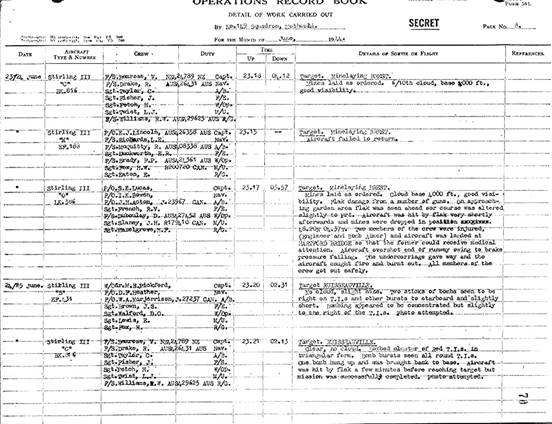
Above is a scanned copy of the Squadron ORB (Operational Record Book) for the last Op of OJ-M, serial EF188. (2nd Entry) Courtesy of J Johnston
Mine Laying Missions.
Although not as glamorous as attacks on the big industrial cities, these missions were a vital part of the Allies efforts to keep shipping and U-Boats penned up in the Brest area. Brest was the scene of much bombing and mine laying activity throughout the War, being in some of the first raids that were carried out by the RAF.
The mine laying trips carried out throughout the war were known as "Gardening,” flights and as such, all mine laying flights were given this title. The crews sometimes referred laconically to their mines as ‘Vegetables’.
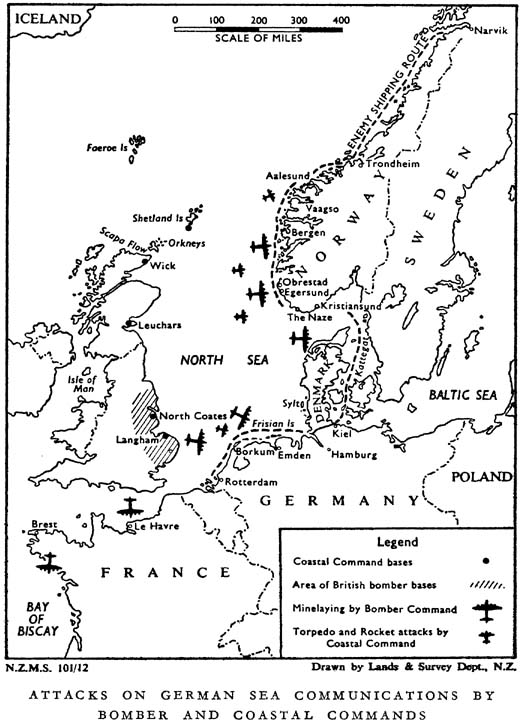
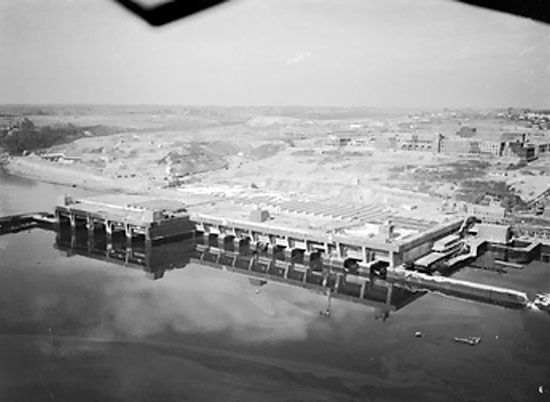
The U-Boat Pens at Brest.
Source - Unknown
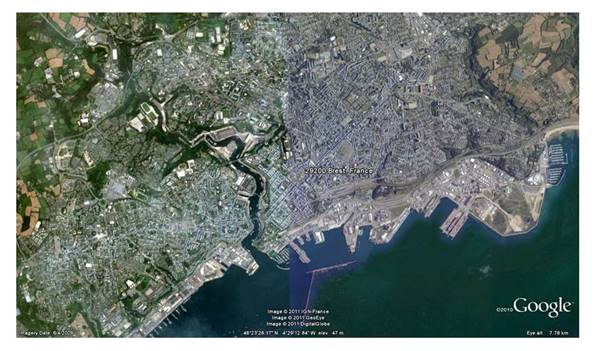
A medium altitude view of Brest. Mine Laying was carried out at low altitudes, making the bombers very susceptible to the shore (Flack) defences.
Source – Google Earth
The Operation.
The defences at Brest were well known and treated with a great deal of respect by the crews, whether bombing or mine laying in the area. The mine laying Operation followed a bombing raid on the harbour area, so the Flak gunners had had plenty of time to ‘get their eye in’. As the crew approached their drop zone at Brest they were hit by heavy ‘Flak’ and the aircraft caught fire.
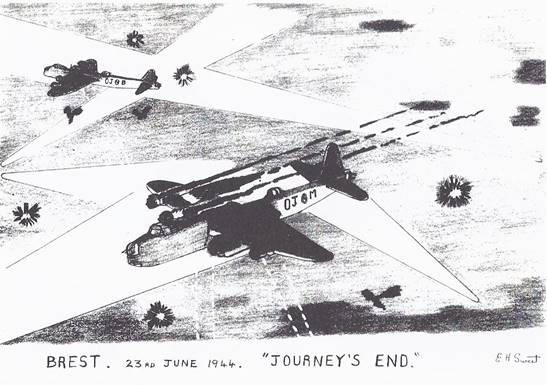
Drawing by E H Sweet, a Sgt W.Op on OJ-B that night. From the book, “Enemy Below”, published by Square One Publications, with permission.
Loss of OJ-M. by Sgt Ted Sweet, Wireless Operator. (OJ-B).
Flt Sgt Bemrose, a New Zealander, and his crew led the four Stirlings flying in loose formation through the ‘Flack’ box over the town and Port of Brest. At 3000ft we were at a suicidal height for the enemy Flack which, up ‘til now, hadn’t bothered us, being been light and inaccurate. The intelligence officer at briefing had indicated a safe corridor through the flack areas to assist us in our let down to 2000ft to drop our mines into Brest harbour. Bemrose was two minutes ahead of B-Baker (our favourite aircraft) and had an uninterrupted run to drop his mines. Leaving B for Baker next in. The sky suddenly lit up brilliantly with a score of searchlights, which could not fail to lock onto us accurately. All around us erupted into Flack bursts. Dull red flashes were followed by black smoke.
It was (so) close you could smell the acrid stink of the cordite and the Flack rattled on the sides of the aircraft. The Bomb Aimer, who usually helped the Pilot in the second dicky seat, was down in the bomb aimer’s position preparing to drop the mines.
The Pilot called me up to help with the propeller speed controls. He threw the plane all over the sky, to try and shake off the Master-controlled radar searchlight that had locked onto us. There was a blinding explosion on our port side and we had a brief glimpse of a Stirling with one engine (Actually, two engines and the starboard fuselage) on fire, going down in a spiral. From that height it was only a few seconds before it hit the ground in a massive explosion as the four sea mines on board exploded. (Actually it was the fuel that blew up in the initial impact, the mines blew up later). Only three of us left now………
Later, when taxiing into “ B for Beer’s” dispersal at Methwold, we began to reflect on our good fortune at (having) returning undamaged. Maisie, the WAAF crew bus driver skidded to a halt in front of our aircraft – we would get all the right ‘Gen’, now. Better, in fact, than if the ‘Wingco’ had told us. Breathlessly she blurted out, “ M for Mother’s been shot down, O for Oboe has crash landed at Canvey Island (Later confirmed as Hartford Bridge), Bemrose has landed away – you lot are the only ones to came back!”
From the book, ‘Enemy Below’, by Ted Sweet. With permission of Square One Publications.
(Author – my notes in italics)
After being hit by the Flack, the aircraft carried on to its doom; tragically the story was not yet complete…... The account below is freely translated from the original French language.
Night of terror at TRAON BROUENNES (Plougonvelin)
On the night of 23/24 June 1944, the 1,757th night of the war, about 2 am, a bomb attack on the Port of Brest ended. The ‘planes had left, the lights gone out, everything was calm. Dawn’s first glow gave substance to the outline of the surroundings. The sky was clear.
Living at Traon Brouen, in Plougonvelin, was Jean-François Bleas and his family. He had hesitated to wake the children up and give the signal to go to the family shelter on this night of raids. Despite the noise of the Flak, familiarity with it had helped in this decision. This raid had been a moderate one and many families had found it unnecessary to seek refuge that night. They had seen far worse and more urgent faces of danger.
Jean-Francois was a good Christian, faithful to his beliefs. He had prayed for a long time at the foot of the bed before retiring that night; More so than other days. For a moment, as he held his head between his hands to collect his thoughts for his prayer, his youngest girl, three years old in a month’s time, had come to kneel with her father. They had showed their pious devotion to the creator, from a family who had joyfully celebrated the Feast of God on Sunday last. For that feast, the children had been clothed in their finest. The return to the farm on a horse-drawn wagon was made with bursts of laughter. They breathed the joy of living.
Reassured by the end of the first raid, Jean-Francois tried to sleep, but could not. He cocked his ears again…. Ten or fifteen minutes later he detected a dull roar in the distance; very distant echoes in the night. From that moment on, the countdown to the cruel fate of the inhabitants of the farm began. The children were sleeping peacefully, but a bomber was approaching ….. and the sound of the engines grew louder.
This was not the usual noise a bomber made as it approached. It was as if the engines were struggling and on the point of failing. Jean-François, despite the unusual engines note, did not worry himself unduly.
Suddenly the spotlight at Ty Baol, a small hamlet barely 300 meters away from the farm, turned its beam on. Almost immediately it settled on the bomber and bathed it in a bright, white light. Trapped in this terrible light, the bomber bored on. It appeared to be holding the same course, but curiously, the Flak guns were silent.
Almost certainly hit by the harbour Flak defences, as it arrived at the north coast of Finistere, the bomber was in trouble. It was a four engined RAF bomber, serial numbered EF188 of 149 squadron, in dire distress.
Eyewitnesses, who saw the bomber in its final moments, saw it surrounded by flames.
Two of the seven crew members: the Navigator, Leslie RICHARDS, 21, and the Wireless Operator, Frank BRADY had (according to the archives of the RAF) parachuted out of the stricken aircraft over the sea, whilst there was still time. Five airmen had not left the aircraft, surrounded as it was by flames. Some of them may have been injured.
(The above paragraph seems to be incorrect, in that the bodies of seven crew members were recovered from the site, despite the reports showing five. See the letter signed by ‘Le Goasguan’ with the Sub-Prefecture of Brest stamp – Author)
The aircraft, which had taken off from its RAF Methwold base in England, was a Short ‘Stirling’ bomber. You can imagine the desperate efforts of the 23 year old pilot, Ted LINCOLN, trying to keep control of his aircraft, gradually losing altitude ... tragically face to face with death for him and his crew.
A great spirit of comradeship existed amongst the volunteers serving in bombers. They grew into very close teams. Only six days previously, the Australians, Ted LINCOLN and Frank BRADY, had been invited to lunch at the home of the parents of Leslie RICHARDS. They had posed for a photo near the trees in the garden.
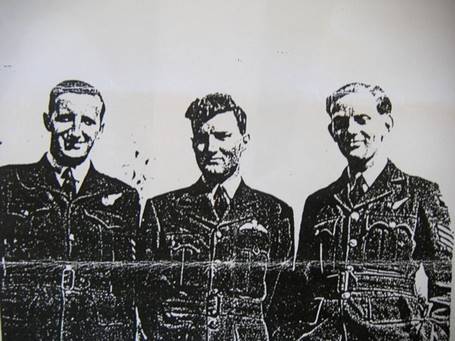
Brady, Lincoln and Richards a few days before their loss.
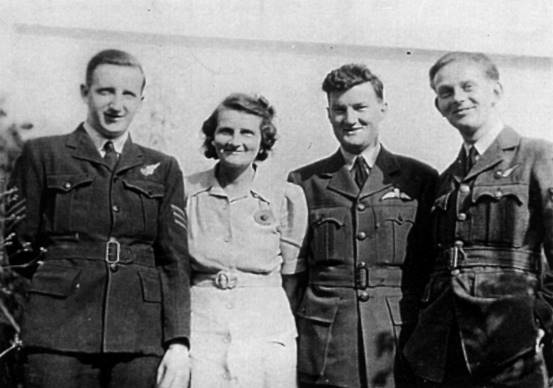
Frank Brady, Mrs Violet Richards, Ted Lincoln and Leslie Richards
On that Tuesday night off, before the Operation, Leslie Richards, talking with his father, spoke of the cruel fate of those women and children who were
below them when they dropped their bombs in the target area. This side of the war had seemed to affect him, but all wars have innocent victims. Leslie's sister, Iris, was serving as an aircraft mechanic at an RAF base as W.A.A.F. She was ‘doing her bit’ for the War effort. Richards’ parents had already been ‘Blitzed’ in their home in Bristol. It had been totally destroyed. His mother had lost two brothers during the war of 1914/18 and she feared for her son …. he could share their fate.
The bomber, which was on a mine laying mission in the harbour of Brest, was still a prisoner of the Ty Baol search light. It was in the last stage of its flight. Passing very low over the town of Ploumoguer, its flames were reflected in the church clock. Dogs, frightened by the roar of its engines, pulled on their leases and angrily barked; frightened by the aircraft that was coming right towards them. The searchlight personnel suddenly extinguished their beam and rushed into the shelters…..
At Traon Brouen, the 22 year old farm boy had roused and was in the hallway, about to leave the house. Upstairs, the children were asleep. At the bottom of the stairs, in a tidy pile (to facilitate a rapid exit), shoes large and small lay beside the small wicker basket containing the family treasures. These must be preserved at all costs! Everything was planned, but the brutality of War made these precautions worthless.
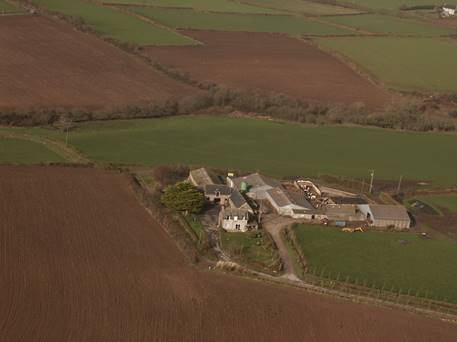
The Farmhouse, Toul (Taon) Brouen.
Everything happened very quickly. A curtain of trees lay in the path of the aircraft.
It struck them at their mid height, before crashing into the first floor of the house ….. where the children slept. The roof was thrown onto the twisting floor and burning in a moment. A gigantic fireball rose above the farm,
over 20 meters high, and died back a short time later. The fireball was the burning fuel tanks and their contents. Machine gun bullets crackled in the flames. Piles of hay, straw and some farm outbuildings caught fire. In this inferno of flames, some were already dead, while others struggled for survival. The remaining crew members, thrown into the surrounding fields or trapped in the rubble, died, some horribly burned. One of them, Edward Eaton, was found in a field near his Browning machine guns. The remains of the others were later recovered from the rubble.
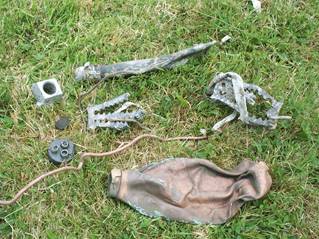
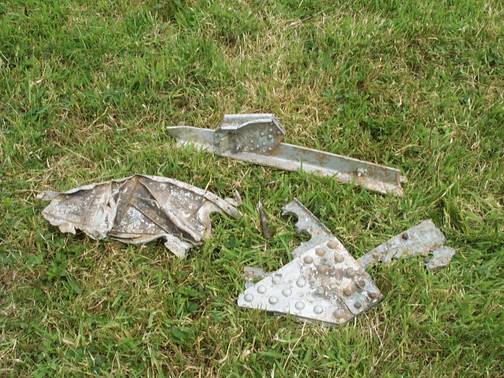
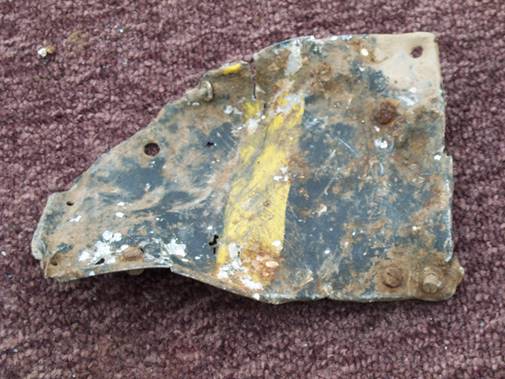
Fragments of EF188 recovered from the crash site.
Courtesy Gildas Saouzanet, Brest Flying Club.
The Mayor of Plougonvelin, Mr. Le Goasguen, thinking that one or more members of the crew may have parachuted to safety, convinced the Germans that the body count was complete. He was right, but unfortunately the two airmen who had the time to jump had died too ... their bodies were washed up from the sea later. (This last statement is contradicted in the same person’s report to the Authorities. See letter - Author)
Without dwelling on the cruel fate that had struck the family Bléas, it is said, simply, that children of two, five and twelve years, and the farm boy were killed in this Dante’s inferno. Jean-Francois, horribly burnt while passing through the wall of flames that surrounded him on all sides, died on the night of the 25th.
The only survivors of the tragedy, the Mother and Leonie, the daughter, fled together to Kergasnou, soon followed by Jean-François who was carried with great care by some men who had rushed to the scene. (Again, contradicted in the official report – Author) Warned of the tragedy, the rector of Locmaria, the Beadle and Dr. Bossard reached Kergasnou and provided first aid, but Jean-Francois was seriously injured and was taken to the Lequerré clinic at Plougonvelin.
Immediately after the initial drama subsided, the German searchlight crew placed sentries at all access points to prevent the civilians, the brave neighbours involved, from risking their lives.
They had saved what they could ... farm machinery, farm animals ... some calves, foals and pigs. They had hoisted the tin roof of a cowshed from a heifer and a fat pig. The door had been blocked by flames. The herd of cows that had been left in the fields outside, escaped the disaster.
A German sidecar came from Brest and after a rough search for escaped airmen at Locmaria, went to the scene of the crash. One of the Germans took the papers of one of the airmen; they were looking for anything which could identify the ‘plane.
.
Eight to nine neighbours worked freely, despite all the dangers (the mines had not yet blown up) all night. They were searching for any sign of life and protecting the property that had not been engulfed in flames.
A mare, mad with grief, had long circled around a burning stall enclosing her foal before she went herself into the fire. Only men of great fortitude and generous heart could cope with this nightmare world. They did so until the end. Almost all came back the next day, after a short break at home. At seven o'clock in the morning an ambulance took the wounded to Kergasnou. The rescuers of the night before had just returned to their homes. Suddenly, a series of explosions occurred at Traon Brouen, causing extensive damage ... the ground floor of the house was blown up, stables, barns and a shed were destroyed. Both mares were killed as a result of the devastating impact. At half past eleven, when the Mass ended at Plougonvelin, three explosions shook the windows of the church. It is said that these explosions were caused by German bomb disposal personnel, with little knowledge of Mines, blowing themselves up; some of them had died. There is no doubt that it was these delayed explosions that caused the most damage.
At 3:30 in the afternoon, a group of "13th Landesschützen Kompanie der Luftwaffe" (13th company of infantry engineers in the German air force) climbed aboard a van and set off for Kerfautras Cemetery in Brest with four coffins. On the shoulder of one garment could be read, ‘ CANADA’ (Fox was Canadian). Coffins of the other crew members were taken by another German group later and transported to Plougonvelin cemetery (In 1981, these airmen were re-buried in the cemetery of St. Charles de Percy in Normandy. The graves of Lincoln, Fox, Richards and Brady are still at Kerfautras).
On Saturday, a few fires still existed here and there. On Monday morning, the clearing of the remaining debris began. (a start had already been made by the first rescuers). Wreckage from the bomber had been thrown all around the farm and there was a tangle of cables and plates around the house. In a show of support, led by Jean Lamour, neighbours set to, to reap the harvest, plough the fields and care for the livestock. These dedicated volunteers had been inspired by the tragic drama that had struck the farm.
Later, the mother and daughter, after a short period of rest and relaxation with family, returned to live at Traon Brouen, to fulfil the promise made to Jean-Francois before his death. First living in a barn and then in a wooden cowshed, they faced life bravely.
How can you not marvel at the generosity of the agricultural world ? How can you not admire the courage and tenacity, in the face of extraordinary physical and moral suffering, of the wife of Jean-François? She had witnessed in a short period of time the collapse of the entire world she had patiently created for her family. She had found herself alone in life, trying to run a farm for the support and happiness of her little Leonie. Even if the heart rending losses of June 24 would eventually heal, she would always have vivid memories of her loved ones.
(This account seems stylised and contains information that cannot be confirmed – Author)
And After…..
For 35 years, the mother of Ted Lincoln (the pilot), corresponded with the family at Traon Brouen. She had also erected a memorial in Sydney, in a tribute to her son. The mother of another airman, Ernie Duckworth, came to visit the scene after the war. The mother of Leslie Richards had never recovered from the loss of her son. She died in December 1983. Leslie's sister managed to come with her daughter to visit the grave in Kerfautras in 1984.
Finally, moved by this tragedy a Glasgow committee, under the aegis of Miss Anderson and Lord Inverclyde, whose purpose was to try to heal the wounds of the children most severely affected by war, selected Leonie Bleas to spend three months in Scotland. Fifteen other little orphans like her took off from Le Bourget on May 3, 1946 for this visit.
The bomber EF188 was not the only one lost on June 24th from 149 Squadron. Of their four bombers which had left England for this attack, only one returned safely to base. The squadron had lost two crews as victims of the Flak defences and one crashed on return from the mission.
On June 27, 1987, a monument recalling this tragic event was erected at the site of the house, at the behest of the Cacqueray Family. It was dedicated in the presence of Mr. Louis Caradec, mayor of the town, the parish rector, Mr. Cheminant from the General Counsel, and Mr. Goasduff, deputy. The dedication was followed by the presentation of the ‘Croix de Chevalier du Mérite Agricole’ to Ms Bleas.
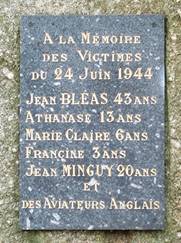
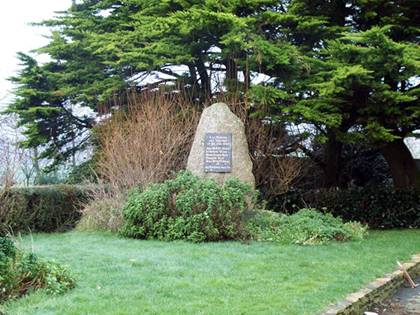
The memorial at the Farmhouse crash site, Traon Brouen
On January the 4th, 1989, in the presence of a large and emotional audience, the funeral of this brave mother was celebrated in the parish church of Plougonvelin. ”She was a wonderful lady,” said Leslie Richards’s sister, on learning of the sad news.
Brest Authorities Paperwork.
The following document copies were contributed by Gildas Saouzanet.
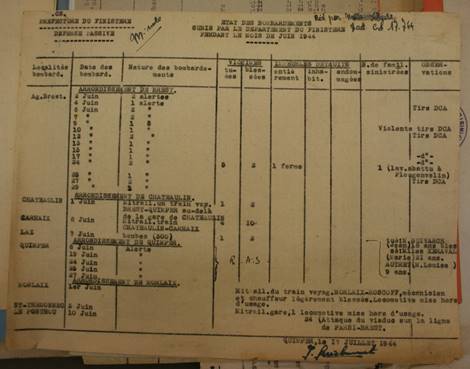
Raids Reports covering the crash.
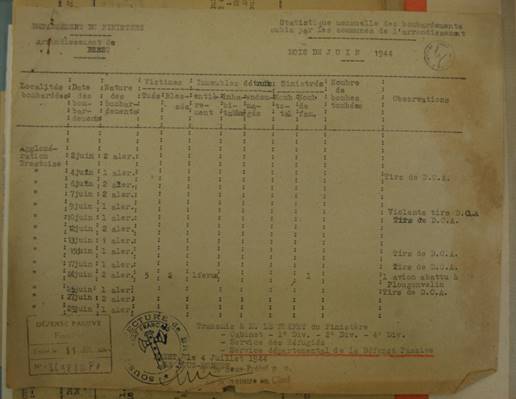
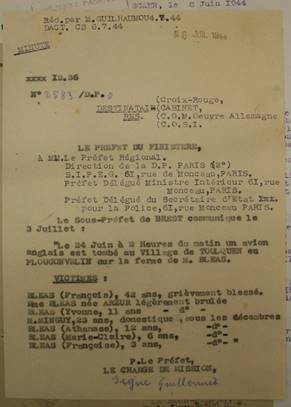
Reports covering the crash. Father grievously burned, Mother and Leonie (Yvonne), slightly burned. The other family victims were under the rubble, little was found.
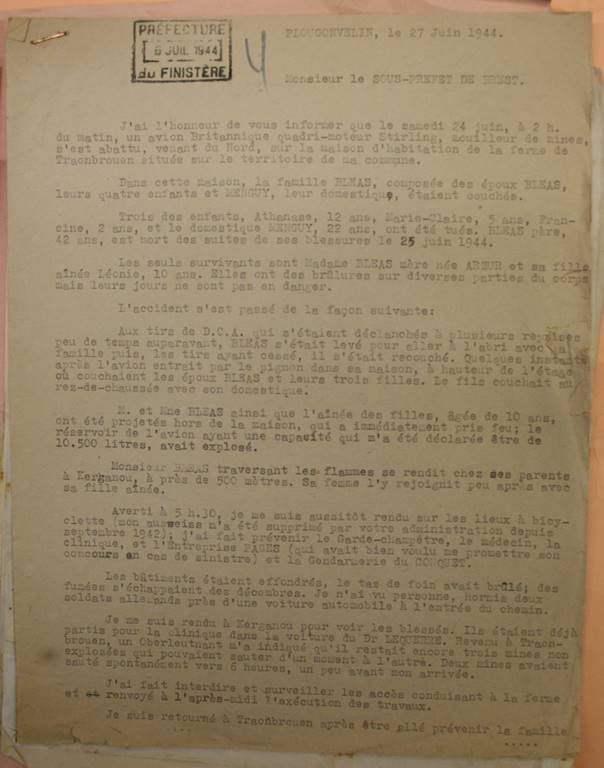 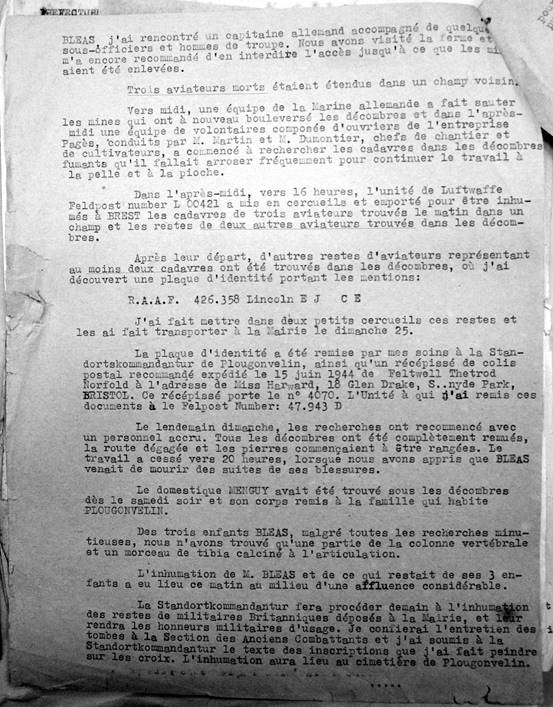 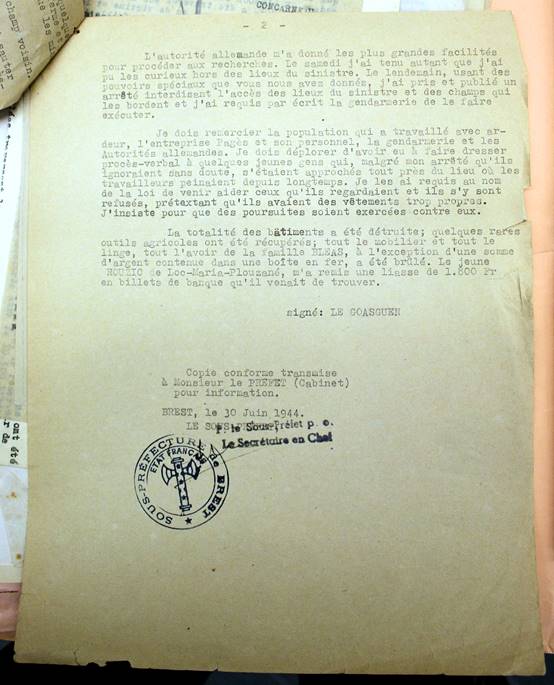
The three page letter above details the incident and follow up actions of the Authorities at Brest.
The Graves.
BREST (Kerfautras) Cemetery
(Finistere France)
|
Photo Courtesy Paul Smith |
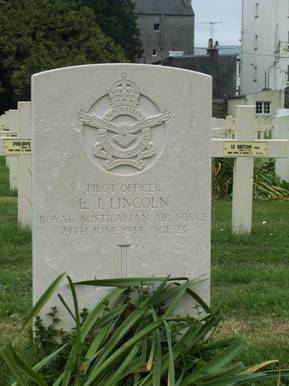
(Above) Pilot Officer. (Pilot) LINCOLN, EDWARD JAMES, 23 yrs old. Royal Australian Air Force. Plot 47. Row 1. Grave 15. BREST (KERFAUTRAS) CEMETERY. Son of Edward Luxmere Lincoln and Ida Josephine Lincoln, of Southport, Queensland, Australia
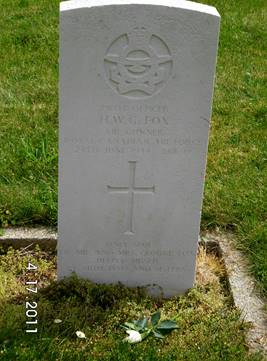
(Above) Pilot Officer (Air Gnr.). FOX, HOWARD WILLIAM GEORGE, 19 yrs old. Royal Canadian Air Force. Plot 47. Row 3. Grave 13. BREST (KERFAUTRAS) CEMETERY. Son of George F. Fox and Kate Fox, of St. Catharine’s, Ontario, Canada
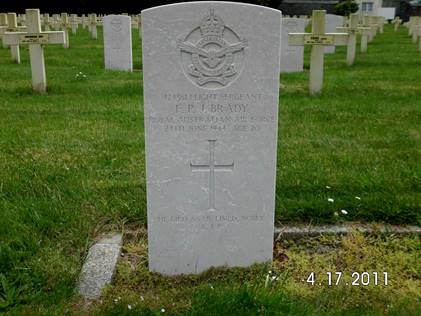
(Above) Flight Sergeant. (Wireless Operator) BRADY, FRANCIS PATRICK JOSEPH, 20 yrs old. Royal Australian Air Force. Plot 47. Row 3. Grave 14. BREST (KERFAUTRAS) CEMETERY. Son of Francis Joseph Stanislaus Brady & Elizabeth Kearins of Mugga Mugga, NSW.
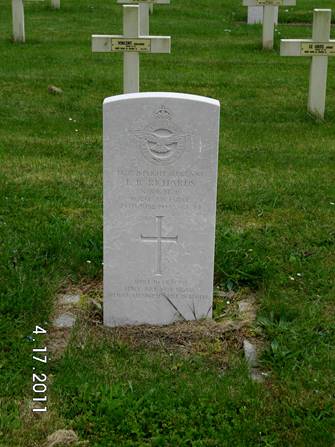
(Above) Flight Sergeant (Nav.). RICHARDS, LESLIE REGINALD, 20 yrs old.. Plot 47. Row 2. Grave 16. BREST (KERFAUTRAS) CEMETERY. Son of Reginald Edgar and Violet Richards, of Sea Mills, Gloucestershire.
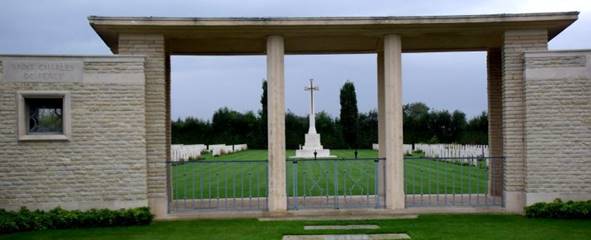
ST. CHARLES DE PERCY WAR CEMETERY,
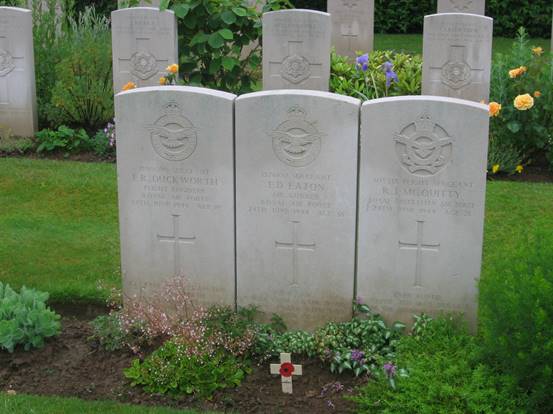
ST. CHARLES DE PERCY, Resting place of:
Sergeant (Flt. Engr.). DUCKWORTH, ERNEST RICHARD, 19 yrs old. Coll. grave 4. B. 5-6. ST. CHARLES DE PERCY WAR CEMETERY. Son of Ellen A. Duckworth, of Crayford, Kent.
Sergeant (Air Gnr). EATON, EDWARD DENIS, 36 yrs old. Coll. grave. 4. B. 5-6. ST. CHARLES DE PERCY WAR CEMETERY. –Son of Edward Denis and Frances Elizabeth Eaton; Husband of Frances Eaton, of Harton, Co. Durham.
Flight Sergeant. (Air Gnr) McQUITTY, ROBERT JOHN, 21 yrs old. Royal Australian Air Force. Coll grave 4. B. 5-6. ST. CHARLES DE PERCY WAR CEMETERY. Son of James and Kate Marie Proctor McQuitty, of Hobart, Tasmania, Australia.
They went with songs to the battle, they were young.
Straight of limb, true of eyes, steady and aglow.
They were staunch to the end against odds uncounted,
They fell with their faces to the foe.
They shall grow not old, as we that are left grow old:
Age shall not weary them, nor the years condemn.
At the going down of the sun and in the morning,
We will remember them.
Acknowledgements:
My thanks to the following for their assistance:
Mrs Sue Whiteley, For her information on Frank Brady.
Mr Gildas Saouzanet, Brest Flying Club, for his unending work in support of relatives of lost aircrew, and the invaluable information passed to me.
Sources:
E.D Sweet, Sgt W/Op, 149 Sqn (deceased)
Square One Publications.
149 Sqn ORBs
149 Archives
Strong By Night by John Johnston. 149 Sqn History
RAF-Commands - Forum members.
Bill Chorley’s BCL Vol 5
RETURN TO INDEX
|
|
 Stirling Pilott
Stirling Pilott 
 Stirling Pilott
Stirling Pilott 